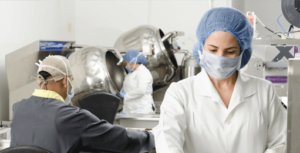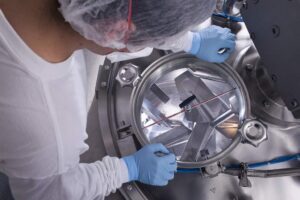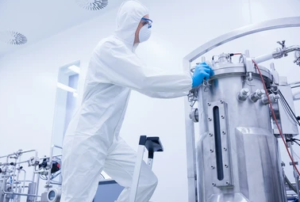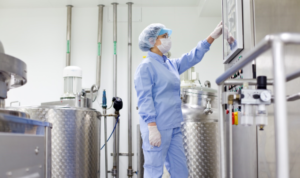News Blog
Keep up to date with the latest news, insights and features from Pharma Hygiene Products
A Guide To Pharmaceutical Mixing
May 22, 2023
Mixing is the main process utilized in the manufacturing of various pharmaceutical products. The proper mixing of components increases the uniformity of drug content. If the mixing process is not proper, it will affect the quality of pharmaceutical products and their ability to meet industry standards.
And so selecting the right type of mixing as part of the production process is key for all companies developing pharmaceuticals, be they pharmaceutical companies, or contract manufacturing organizations.

What is pharmaceutical mixing?
Mixing can be defined as the process of two or more components being combined in a mixed condition so that the particles of one of the ingredients are lying as close as is possible to the adjacent particles of the other ingredients. In pharmaceutical terms the word compounding is used to refer to the mixing of two or more drugs.
Mixing is an important part of producing pharmaceutical products and includes dissolving solids and powders, combining raw materials, preparing emulsions, milling of active pharmaceutical ingredients (APIs) and enabling chemical reactions.

Application of Mixing in Pharmaceutical Processing
Mixing ingredients can serve multiple purposes in pharmaceutical processing such as producing a suspension, improving dissolution and diffusion of a mixture, enhancing either physical or chemical reactions, ensuring uniformity of mixed ingredients, and creating a true solution from two miscible liquids.

Types of Mixing Used in The Pharmaceutical Industry
Examples of mixers often used in a pharmaceutical setting include shaker mixers, propeller mixers, turbine mixers, and paddle mixers including gate stirrers and spiral stirrers.
There are 3 key modes of action used in pharmaceutical mixing, convective, diffusive and shear mixing.
1. Convective Mixing
Convective mixing creates a circulating flow of ingredients, often caused by the rotation of the mixer vessel, combined with an agitator such as a ribbon or paddle, and even a gas flow. It is often used in batch mode operations, contributing to mixing of bulk powder mixtures, however the final mixture can exhibit poor mixing characteristics at a finer scale.
2. Diffusive Mixing
Diffusive mixing, also known as random all phenomenon, is achieved through the random motion of the particles. The rate of mix is considerably slower than convective but achieves microscopic homogenization. Therefore, diffusive mixing is the first choice for axial mixing, especially of gases and liquids. Sometimes a combination of convective and diffusive is used to combine speed and effectiveness.
3. Shear Mixing
Sheer mixing lends itself to both batch and in line mixing operations. It is induced by momentum exchange of the particles of the ingredients which have different velocities. It is often used in the production of creams, emollients, ointments, and suspension products such as syrups. It works well where the ingredients would not easily mix. High sheer mixing can be used when the ingredients require a more vigorous action to evenly distribute, such as oil and water formulations, or where there are solids that require broken down. High sheer mixing also works well when ingredients have different viscosity levels.

Pharmaceutical Mixing with Pharma Hygiene Products
International Cleanroom Standard
Our mixing products at Pharma Hygiene Products are designed to be of international cleanroom quality, made of 304 grade steel with 316L pharmaceutical grade wetted parts. This combined with a high level of finishing, creates and easy to clean surface that is pit and crevice free and can be sterilised.
Our products have full traceability for international pharma-quality compliance, and material grade, surface finish, and TSE certification are available on request.
Mixers To Suit Your Ingredient Needs
Our high sheer mixers are ideal for mixing water to oil recipe to form an emulsion. The unit operates at 2,900RPM and can accommodate batch sizes from 20 litres to 300 litres. We can adjust the mixer options to suit batch size and viscosity. The mixers benefit from variable speeds, and motor shroud to reduce noise. The vessels can be supplied with lockable wheels to allow for mobility.
Our Propeller Mixers
Or propeller mixers excel at liquid to liquid, oil to oil and free dissolving powder to liquid ingredient combinations. The hygienic and powerful blades work at 1,400 RPM. Propellers are designed for batch sizes from 20L to 300L, with a maximum diameter of base vessel of 800mm. The motors have variable speeds, and the total solution can be provided with a mobile frame if required.
This short article is intended to give the reader a top-line understanding of the mixing needs in pharmaceutical mixing. It is not exhaustive and is always worth speaking with one of our expert sales team to understand more about your specific needs. To contact us, you are welcome to call +44(0)1444 472300, email info@pharmahygieneproducts.com or chat live on our website now.
 Chat with us!
Chat with us!